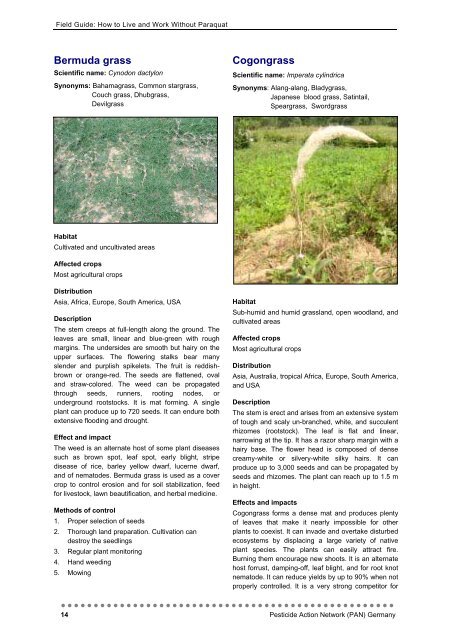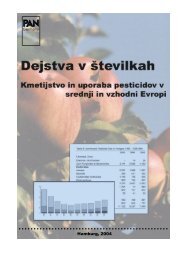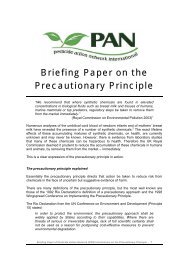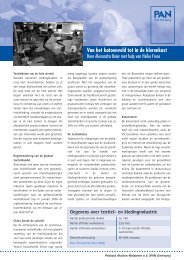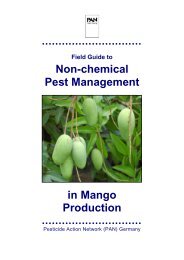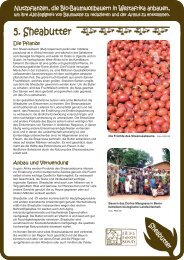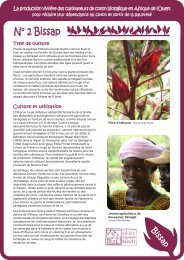Field Guide: How to Grow Crops without Paraquat - Online ...
Field Guide: How to Grow Crops without Paraquat - Online ...
Field Guide: How to Grow Crops without Paraquat - Online ...
Create successful ePaper yourself
Turn your PDF publications into a flip-book with our unique Google optimized e-Paper software.
<strong>Field</strong> <strong>Guide</strong>: <strong>How</strong> <strong>to</strong> Live and Work Without <strong>Paraquat</strong><br />
Bermuda grass<br />
Scientific name: Cynodon dactylon<br />
Synonyms: Bahamagrass, Common stargrass,<br />
Couch grass, Dhubgrass,<br />
Devilgrass<br />
Cogongrass<br />
Scientific name: Imperata cylindrica<br />
Synonyms: Alang-alang, Bladygrass,<br />
Japanese blood grass, Satintail,<br />
Speargrass, Swordgrass<br />
Habitat<br />
Cultivated and uncultivated areas<br />
Affected crops<br />
Most agricultural crops<br />
Distribution<br />
Asia, Africa, Europe, South America, USA<br />
Description<br />
The stem creeps at full-length along the ground. The<br />
leaves are small, linear and blue-green with rough<br />
margins. The undersides are smooth but hairy on the<br />
upper surfaces. The flowering stalks bear many<br />
slender and purplish spikelets. The fruit is reddishbrown<br />
or orange-red. The seeds are flattened, oval<br />
and straw-colored. The weed can be propagated<br />
through seeds, runners, rooting nodes, or<br />
underground roots<strong>to</strong>cks. It is mat forming. A single<br />
plant can produce up <strong>to</strong> 720 seeds. It can endure both<br />
extensive flooding and drought.<br />
Effect and impact<br />
The weed is an alternate host of some plant diseases<br />
such as brown spot, leaf spot, early blight, stripe<br />
disease of rice, barley yellow dwarf, lucerne dwarf,<br />
and of nema<strong>to</strong>des. Bermuda grass is used as a cover<br />
crop <strong>to</strong> control erosion and for soil stabilization, feed<br />
for lives<strong>to</strong>ck, lawn beautification, and herbal medicine.<br />
Methods of control<br />
1. Proper selection of seeds<br />
2. Thorough land preparation. Cultivation can<br />
destroy the seedlings<br />
3. Regular plant moni<strong>to</strong>ring<br />
4. Hand weeding<br />
5. Mowing<br />
Habitat<br />
Sub-humid and humid grassland, open woodland, and<br />
cultivated areas<br />
Affected crops<br />
Most agricultural crops<br />
Distribution<br />
Asia, Australia, tropical Africa, Europe, South America,<br />
and USA<br />
Description<br />
The stem is erect and arises from an extensive system<br />
of <strong>to</strong>ugh and scaly un-branched, white, and succulent<br />
rhizomes (roots<strong>to</strong>ck). The leaf is flat and linear,<br />
narrowing at the tip. It has a razor sharp margin with a<br />
hairy base. The flower head is composed of dense<br />
creamy-white or silvery-white silky hairs. It can<br />
produce up <strong>to</strong> 3,000 seeds and can be propagated by<br />
seeds and rhizomes. The plant can reach up <strong>to</strong> 1.5 m<br />
in height.<br />
Effects and impacts<br />
Cogongrass forms a dense mat and produces plenty<br />
of leaves that make it nearly impossible for other<br />
plants <strong>to</strong> coexist. It can invade and overtake disturbed<br />
ecosystems by displacing a large variety of native<br />
plant species. The plants can easily attract fire.<br />
Burning them encourage new shoots. It is an alternate<br />
host forrust, damping-off, leaf blight, and for root knot<br />
nema<strong>to</strong>de. It can reduce yields by up <strong>to</strong> 90% when not<br />
properly controlled. It is a very strong competi<strong>to</strong>r for<br />
•••••••••••••••••••••••••••••••••••••••••••••••••••<br />
14 Pesticide Action Network (PAN) Germany


